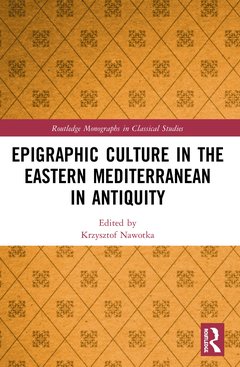Epigraphic Culture in the Eastern Mediterranean in Antiquity Routledge Monographs in Classical Studies Series
Coordonnateur : Nawotka Krzysztof

This book investigates the epigraphic habit of the Eastern Mediterranean in antiquity, from the inception of alphabetic writing to the seventh c. CE, aiming to identify whether there was one universal epigraphic culture in this area or a number of discrete epigraphic cultures.
Chapters examine epigraphic culture(s) through quantitative analysis of 32,062 inscriptions sampled from ten areas in the Eastern Mediterranean, from the Black Sea coast to Greece, western to central Asia Minor, Phoenicia to Egypt. They show that the shapes of the epigraphic curves are due to different factors occurring in different geographical areas and in various epochs, including the pre-Greek epigraphic habit, the moment of urbanization and Hellenization, and the organized Roman presence. Two epigraphic maxima are identified in the Eastern Mediterranean: in the third c. BCE and in the second c. CE. This book differs from previous studies of ancient epigraphic culture by taking into account all categories of inscriptions, not just epitaphs, and in investigating a much broader area over the broadly defined classical antiquity.
This volume is a valuable resource for anyone working on ancient epigraphy, history or the cultures of the Eastern Mediterranean.
Introduction: Epigraphic habit, epigraphic culture, epigraphic curve: statement of the problem 1. The epigraphic curve in Boiotia 2. The epigraphic curve at Delphi 3. Epigraphic Culture in Olympia 4. The Epigraphic Curve in the Black Sea Region: A Case Study from North-West Pontus5. The Epigraphic curve in the Northern Black Sea region: A case study from Chersonesos and the Bosporan Kingdom 6. Epigraphic curves in Western Asia Minor: the case studies of Miletos, Ephesos and Pergamon7. The Epigraphic Curve in Phrygia and its Borderlands8. The Epigraphic Curve in the Levant: The Case Study of Phoenicia9. The epigraphic curve in Egypt: the case study of Alexandria10. The Epigraphic Curve in the Fayum OasisConclusions: One or many epigraphic cultures in the Eastern Mediterranean
Krzysztof Nawotka is an ancient historian, Greek epigrapher and classicist educated in Wrocław, Poland; Oxford, UK; and Columbus, USA; Ph.D. (1991), The Ohio State University. He is currently Professor of Ancient History at the University of Wrocław, Poland, and previously held positions as Honorary Research Fellow at the University of Liverpool, Visiting Scholar at Brown University and Visiting Professor at Xiamen University. Since 2015 he has been a member of the Academia Europaea. He has published on Greek cities on the coast of the Black Sea, Greek legislation, Miletos, Alexander the Great and the Alexander Romance. His most recent publication is The Alexander Romance by Ps.-Callisthenes: A Historical Commentary (2017). At present he co-ordinates a research project at the University of Wrocław entitled "Greek City in the Hellenistic and Roman Age and Territorial Powers", funded by the National Science Centre, Poland.
Date de parution : 09-2023
15.6x23.4 cm
Date de parution : 09-2020
15.6x23.4 cm
Thème d’Epigraphic Culture in the Eastern Mediterranean in Antiquity :
Mots-clés :
Epigraphic Habit; Hellenization; Epigraphic Culture; Eastern Mediterranean; Epigraphic Production; classical antiquity; Bosporan Kingdom; urbanization moment; Inscriptiones Graecae; universal epigraphic culture; Epigraphic Activity; Epigraphic Material; Western Asia Minor; Inscriptions Grecques; Hellenistic Age; Mithridates VI Eupator; Fayum Oasis; Herakleia Pontike; Manumission Records; Honorific Decrees; Circus Factions; Antonine Age; Latin Inscriptions; Chronological Distribution; Greco Roman Period; Diocletian’s Price Edict; Egyptian Inscriptions; Kleopatra VII; Mama; CEG



